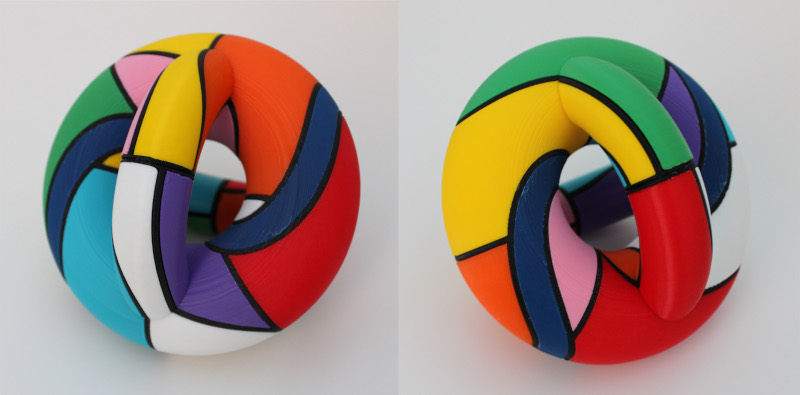NEIGHBORLY NINE
15cm × 15cm × 15cm
3D printed PLA
Bridges 2023 Art Exhibition
BLURB
"One of my favorite mathematical facts is the Map Color Theorem, an analogue of the Four Color Theorem for other surfaces. There are several physical models of maps on the torus and two-holed torus needing the maximum number of colors, so I wanted to take this one step further and show a map of nine mutually adjacent countries on the three-holed torus. This map was described combinatorially by Jungerman and Ringel, and I was pleased to be able to preserve some of the symmetries of their construction. The dark blue 'river' is a cylindrical country: removing it and filling in the holes results in a map of eight mutually adjacent countries on the two-holed torus."
ADDITIONAL COMMENTS
Jungerman and Ringel [1] described how to construct a "minimal triangulation" of the two-holed torus using a map of 10 countries,
For awhile, I struggled with how to transform the map into an aesthetically pleasing 3D model. My first attempts involved treating the map in Figure 2.1 as a sphere and punching out a hole through its poles to merge \(x\) and \(x'\). Eventually, perhaps taking inspiration from models of \(K_7\) in the torus, I realized that the numbered countries can be arranged to "wrap around" a torus. The resulting design was first conceived in 2020 and 3D printed by Shapeways in their full-color sandstone material:

The width of the main torus is only 5cm, so I wanted a larger sculpture for the Bridges submission. Some minor modifications were made to the map so that it would be easier to manufacture using a home FDM 3D printer. Each color was printed in several pieces and glued together.

REFERENCES
- M. Jungerman and G. Ringel, Minimal triangulations of orientable surfaces. Acta Mathematica, 145(1):121–154, 1980.
- G. Ringel, Map Color Theorem, Springer-Verlag, 1974.
